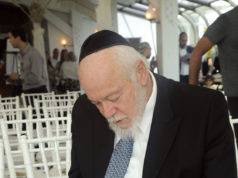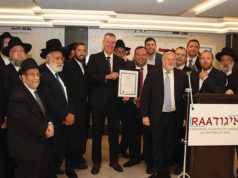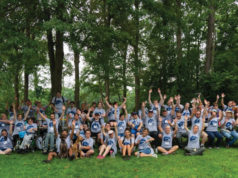
In 1788, the first Jews (between eight and 14) arrived in Australia from England, as part of the fleet of convicts sent there as punishment for petty crimes. It is claimed that Joseph Marcus, a former convict, founded the Jewish community in Sydney in 1817, along with the formation of the Jewish Burial Society (Hevrah Kadishah).
In 1821, the first group of free Jewish settlers arrived in Australia. Reports estimate that by 1828, approximately 100 Jews had moved there. By 1841, this figure had increased to 1,083 and in 1844, the country’s first synagogue was built in Sydney. This inspired many other Jewish communities to establish their own congregations in Melbourne, Adelaide, Brisbane and Perth.

In 1850, gold was discovered and this attracted many immigrants to settle in Australia, including countless Jews. These new Jewish immigrants were involved in the commercial trade of gold, setting up stores along the mining routes. Consequently, Jewish communities were established in these rural areas.
By 1861, 5,486 Jews had settled in Australia and this number greatly increased by 1901, when an estimated 15,000 Jews, mainly British, had immigrated. As the gold supplies began to decrease, many Jews decided to migrate to the cities: Sydney and Melbourne were the two major destinations.

Before the Second World War, thousands of Jewish immigrants arrived from Europe. The number of Holocaust survivors in the Australian Jewish community is among the highest in the world. That’s why Australia’s Jewish community is often referred to as a “Shoah community.” Among the Shoah survivors in post-war Europe, there were many who wanted to put as large a distance as possible between themselves and Europe, making Australia a popular option. The problem however, was that Australia limited immigration to the country. The Executive Council of Australian Jewry lobbied the government to allow Jewish refugees from Europe to come and restart their lives in Australia. In 1945, the government relented, allowing 2,000 close relatives of Jews already living in Australia to immigrate on a humanitarian basis. Then, between the years of 1947 and 1954, Australia received tens of thousands of Jewish immigrants. The 1940s and 1950s witnessed the birth of ultra-Orthodox Judaism in Australia, with the rise of active Chabad Lubavitch communities in Sydney and Melbourne.

The 1980s saw the arrival of thousands of South African Jews. Searching for a safer place to live, they chose Australia, largely for its similarities in climate, language and culture. They integrated quickly and many of the new South African immigrants have assumed leadership roles within the wider Jewish community. They have likewise expanded the Jewish community numerically, especially in places such as Perth, in which the Jewish community has grown from 3,000, in the 1980s, to 8,000 at the latest count. In many cases, these South African immigrants have formed their own sub-communities, within the wider Jewish communities.
During the end of the 1970s, Jews from the former Soviet Union arrived en masse and even more arrived after the fall of communism.
These Jewish immigrants, from various countries, who arrived in Australia with minimal material possessions, have developed valuable skills, which they have combined with a great drive and passion for success. Their commitment has led the younger generation. to careers in business, law, medicine, textiles, academia, the arts and finance.
Australian Jews are generally found within the middle to upper class of society. In 1986, when a survey was compiled of the 200 wealthiest individuals in the country, 25% of the names were of Jewish industrialists.
Their success, initiative and achievements have made a significant contribution to the development of Australia as a whole. Former Australian Prime Minister Robert Hawke was quoted in 1987 as saying that “the whole of Australia has benefited from the work of Australian Jews, which has been incalculable and invaluable.”
Most Australian Jews have a strong Jewish identity. The emphasis on Jewish education is one of the most striking characteristics of Australian Jewry. In 1942, the first Jewish Day School and kindergarten were formed in Sydney and shortly after the war years the first communal Jewish Day School was founded in Melbourne. In its inaugural year, the school had 120 students, and in the 1980s became one of the largest Jewish Day Schools in the Diaspora, with a peak of 2,800. The largest Jewish school in Australia today is Moriah College, in Sydney. It is estimated that in Melbourne between 70% and 75% of all Jewish students attend a Jewish school. In Sydney, this figure is 62%.
In addition to Jewish education at an elementary and high school level, there are also opportunities for Jewish higher education. The University of Sydney and Monash University in Melbourne both offer full Jewish Studies departments. Adult Jewish learning is also very popular in Australia, with the Melton Adult Education Program offering a variety of popular programs linked to the Hebrew University in Jerusalem.
Welfare concerns rank high on the agenda of the Jewish community and are catered to through a number of Jewish organizations and institutions. These include the Jewish old age homes and hospitals in Sydney and Melbourne and the Sydney-based Jewish Care organization, founded in 1935, which deals with children and families of broken homes and/or financially distressed backgrounds.
In 1936, the German Jewish Refugee Fund was established to assist Jews in distress. After the Second World War, this became the Australian Jewish Welfare Society, which assisted Jewish immigrants. Today, Jewish Care continues this help to Jewish immigrants to Australia, as well as providing welfare services for the needy in the Jewish community: the elderly, the physically challenged, people with mental illness, etc.
Prior to 1933, the intermarriage rate in the Australian Jewish community was approximately 30%. This high percentage potentially threatened the future of the community. However, the arrival of Jewish refugees prior to and following World War II, changed the pattern of assimilation. Demographic research indicates that the intermarriage rate dropped immediately after the war and that by 1971, almost 90% of Jewish men and women were married to Jewish partners.
Anti-Semitism was first experienced in Australia in the late 19th century. Until then, Australian Jewry enjoyed full political equality and was in no way oppressed or persecuted. The 19th century gave rise to Australian nationalism. The much-characterized racist nationalist movement not only targeted the Asian community and the Aboriginal people but also the “foreign” Jews. During the period of the great, global depression of the 1930s, the first organized acts of anti-Semitism occurred in Australia. The “New Guard” and the “Australia First Movement” were two right-wing organizations that aligned themselves with Hitler’s Nazism.
The Australian League of Rights, founded in 1945, is possibly the most threatening anti-Semitic organization in Australia. The League markets Jewish conspiracy theories, Holocaust denial and anti-Zionism. It is most active in rural Australia.
In 1990, leaders of a neo-Nazi group under the name of the Australian Nationalist Movement were brought to trial in Perth. It was reported that many of their wrong-doings were outright anti-Jewish and pro-Nazi. A year later, in 1991, in the wake of the Gulf War, escalated fears were met with the bombing of five synagogues in Sydney.
Violence, vandalism and threats are some of the more common acts of anti-Semitism experienced in Australia. Whilst vandalism has somewhat diminished over recent years, as a result of increased vigilance and investment in security on the part of the Jewish community, graffiti—bearing Nazi swastikas and offensive slogans—has been seen covering Jewish cemeteries, synagogues and private homes of Jewish communal leaders. However, relative to other Diaspora communities, Australian Jewry experiences limited anti-Semitism.
Australia’s Jewish population continues to grow in size, activity and importance. Many believe that the large Jewish Russian presence in Australia may change the community’s makeup in the near future, while at the same time, there is potential for this educated community to take more of a lead in international Jewish academia.
Australia has long been a stronghold of Zionist activity and support for the State of Israel and Zionism plays a significant part in community activities. It ranges from Zionist education, fundraising for Israel, successful youth movements and the promotion of aliyah. Seventy-nine percent of the adult Jewish population in Australia are believed to have visited Israel, which is quite extraordinary for a country so far away geographically, and approximately 9,000 Jews are believed to have made aliyah from Australia.
Jews enjoy equal rights and religious freedom, in a progressive, democratic country and they are financially secure, The combination of these factors indicate that the Australian Jewish community can look forward to the future with confidence.



